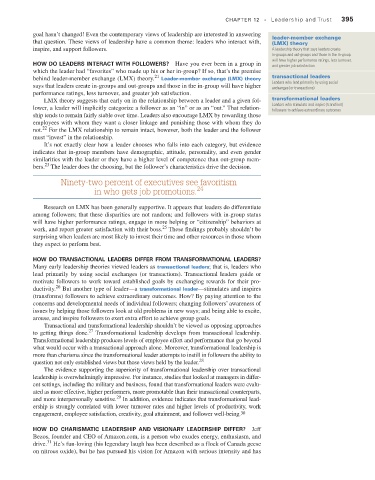Page 396 - Fundamentals of Management Myths Debunked (2017)_Flat
P. 396
CHAPTER 12 • Leadership and Trust 395
goal hasn’t changed! Even the contemporary views of leadership are interested in answering leader-member exchange
that question. These views of leadership have a common theme: leaders who interact with, (LMX) theory
inspire, and support followers. A leadership theory that says leaders create
in-groups and out-groups and those in the in-group
will have higher performance ratings, less turnover,
How do Leaders Interact wItH FoLLowers? Have you ever been in a group in and greater job satisfaction
which the leader had “favorites” who made up his or her in-group? If so, that’s the premise
21
behind leader-member exchange (LMX) theory. Leader-member exchange (LMX) theory transactional leaders
says that leaders create in-groups and out-groups and those in the in-group will have higher Leaders who lead primarily by using social
exchanges (or transactions)
performance ratings, less turnover, and greater job satisfaction.
LMX theory suggests that early on in the relationship between a leader and a given fol- transformational leaders
lower, a leader will implicitly categorize a follower as an “in” or as an “out.” That relation- Leaders who stimulate and inspire (transform)
followers to achieve extraordinary outcomes
ship tends to remain fairly stable over time. Leaders also encourage LMX by rewarding those
employees with whom they want a closer linkage and punishing those with whom they do
22
not. For the LMX relationship to remain intact, however, both the leader and the follower
must “invest” in the relationship.
It’s not exactly clear how a leader chooses who falls into each category, but evidence
indicates that in-group members have demographic, attitude, personality, and even gender
similarities with the leader or they have a higher level of competence than out-group mem-
23
bers. The leader does the choosing, but the follower’s characteristics drive the decision.
Ninety-two percent of executives see favoritism
in who gets job promotions. 24
Research on LMX has been generally supportive. It appears that leaders do differentiate
among followers; that these disparities are not random; and followers with in-group status
will have higher performance ratings, engage in more helping or “citizenship” behaviors at
25
work, and report greater satisfaction with their boss. These findings probably shouldn’t be
surprising when leaders are most likely to invest their time and other resources in those whom
they expect to perform best.
How do transactIonaL Leaders dIFFer From transFormatIonaL Leaders?
Many early leadership theories viewed leaders as transactional leaders; that is, leaders who
lead primarily by using social exchanges (or transactions). Transactional leaders guide or
motivate followers to work toward established goals by exchanging rewards for their pro-
26
ductivity. But another type of leader—a transformational leader—stimulates and inspires
(transforms) followers to achieve extraordinary outcomes. How? By paying attention to the
concerns and developmental needs of individual followers; changing followers’ awareness of
issues by helping those followers look at old problems in new ways; and being able to excite,
arouse, and inspire followers to exert extra effort to achieve group goals.
Transactional and transformational leadership shouldn’t be viewed as opposing approaches
27
to getting things done. Transformational leadership develops from transactional leadership.
Transformational leadership produces levels of employee effort and performance that go beyond
what would occur with a transactional approach alone. Moreover, transformational leadership is
more than charisma since the transformational leader attempts to instill in followers the ability to
question not only established views but those views held by the leader. 28
The evidence supporting the superiority of transformational leadership over transactional
leadership is overwhelmingly impressive. For instance, studies that looked at managers in differ-
ent settings, including the military and business, found that transformational leaders were evalu-
ated as more effective, higher performers, more promotable than their transactional counterparts,
29
and more interpersonally sensitive. In addition, evidence indicates that transformational lead-
ership is strongly correlated with lower turnover rates and higher levels of productivity, work
engagement, employee satisfaction, creativity, goal attainment, and follower well-being. 30
How do cHarIsmatIc LeadersHIp and VIsIonary LeadersHIp dIFFer? Jeff
Bezos, founder and CEO of Amazon.com, is a person who exudes energy, enthusiasm, and
31
drive. He’s fun-loving (his legendary laugh has been described as a flock of Canada geese
on nitrous oxide), but he has pursued his vision for Amazon with serious intensity and has

